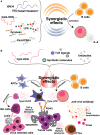Cooperation of Oligodeoxynucleotides and Synthetic Molecules as Enhanced Immune Modulators
- PMID: 31508424
- PMCID: PMC6718720
- DOI: 10.3389/fnut.2019.00140
Cooperation of Oligodeoxynucleotides and Synthetic Molecules as Enhanced Immune Modulators
Abstract
Unmethylated cytosine-guanine dinucleotide (CpG) motifs are potent stimulators of the host immune response. Cellular recognition of CpG motifs occurs via Toll-like receptor 9 (TLR9), which normally activates immune responses to pathogen-associated molecular patterns (PAMPs) indicative of infection. Oligodeoxynucleotides (ODNs) containing unmethylated CpGs mimic the immunostimulatory activity of viral/microbial DNA. Synthetic ODNs harboring CpG motifs resembling those identified in viral/microbial DNA trigger an identical response, such that these immunomodulatory ODNs have therapeutic potential. CpG DNA has been investigated as an agent for the management of malignancy, asthma, allergy, and contagious diseases, and as an adjuvant in immunotherapy. In this review, we discuss the potential synergy between synthetic ODNs and other synthetic molecules and their immunomodulatory effects. We also summarize the different synthetic molecules that function as immune modulators and outline the phenomenon of TLR-mediated immune responses. We previously reported a novel synthetic ODN that acts synergistically with other synthetic molecules (including CpG ODNs, the synthetic triacylated lipopeptide Pam3CSK4, lipopolysaccharide, and zymosan) that could serve as an immune therapy. Additionally, several clinical trials have evaluated the use of CpG ODNs with other immune factors such as granulocyte-macrophage colony-stimulating factor, cytokines, and both endosomal and cell-surface TLR ligands as adjuvants for the augmentation of vaccine activity. Furthermore, we discuss the structural recognition of ODNs by TLRs and the mechanism of functional modulation of TLRs in the context of the potential application of ODNs as wide-spectrum therapeutic agents.
Keywords: ODN; TLR; ligands; molecule; synergy.
Figures

Similar articles
-
Immunostimulatory Properties of Lipid Modified CpG Oligonucleotides.Mol Pharm. 2017 Aug 7;14(8):2815-2823. doi: 10.1021/acs.molpharmaceut.7b00335. Epub 2017 Jul 24. Mol Pharm. 2017. PMID: 28686452
-
Immunostimulatory Activities of CpG-Oligodeoxynucleotides in Teleosts: Toll-Like Receptors 9 and 21.Front Immunol. 2019 Feb 8;10:179. doi: 10.3389/fimmu.2019.00179. eCollection 2019. Front Immunol. 2019. PMID: 30800129 Free PMC article. Review.
-
Single Stranded DNA Immune Modulators with Unmethylated CpG Motifs: Structure and Molecular Recognition by Toll-Like Receptor 9.Curr Protein Pept Sci. 2019;20(11):1060-1068. doi: 10.2174/1389203720666190830162149. Curr Protein Pept Sci. 2019. PMID: 31470785 Review.
-
Therapeutic applications of synthetic CpG oligodeoxynucleotides as TLR9 agonists for immune modulation.BioDrugs. 2007;21(6):387-401. doi: 10.2165/00063030-200721060-00006. BioDrugs. 2007. PMID: 18020622 Review.
-
Monomeric G-Quadruplex-Based CpG Oligodeoxynucleotides as Potent Toll-Like Receptor 9 Agonists.Biomacromolecules. 2020 Sep 14;21(9):3644-3657. doi: 10.1021/acs.biomac.0c00679. Epub 2020 Aug 28. Biomacromolecules. 2020. PMID: 32857497
Cited by
-
The Debate between the Human Microbiota and Immune System in Treating Aerodigestive and Digestive Tract Cancers: A Review.Vaccines (Basel). 2023 Feb 21;11(3):492. doi: 10.3390/vaccines11030492. Vaccines (Basel). 2023. PMID: 36992076 Free PMC article. Review.
-
A novel immunomodulating peptide with potential to complement oligodeoxynucleotide-mediated adjuvanticity in vaccination strategies.Sci Rep. 2024 Nov 5;14(1):26737. doi: 10.1038/s41598-024-78150-7. Sci Rep. 2024. PMID: 39501043 Free PMC article.
-
Chitosan Microparticles Coupled with MAGE-AX and CpGs as a Treatment for Murine Melanoma.Pharmaceutics. 2025 Jul 19;17(7):932. doi: 10.3390/pharmaceutics17070932. Pharmaceutics. 2025. PMID: 40733140 Free PMC article.
-
Cancer Vaccine Therapeutics: Limitations and Effectiveness-A Literature Review.Cells. 2023 Aug 28;12(17):2159. doi: 10.3390/cells12172159. Cells. 2023. PMID: 37681891 Free PMC article. Review.
-
Airway Epithelial-Derived Immune Mediators in COVID-19.Viruses. 2023 Jul 29;15(8):1655. doi: 10.3390/v15081655. Viruses. 2023. PMID: 37631998 Free PMC article. Review.
References
Publication types
LinkOut - more resources
Full Text Sources
Miscellaneous

